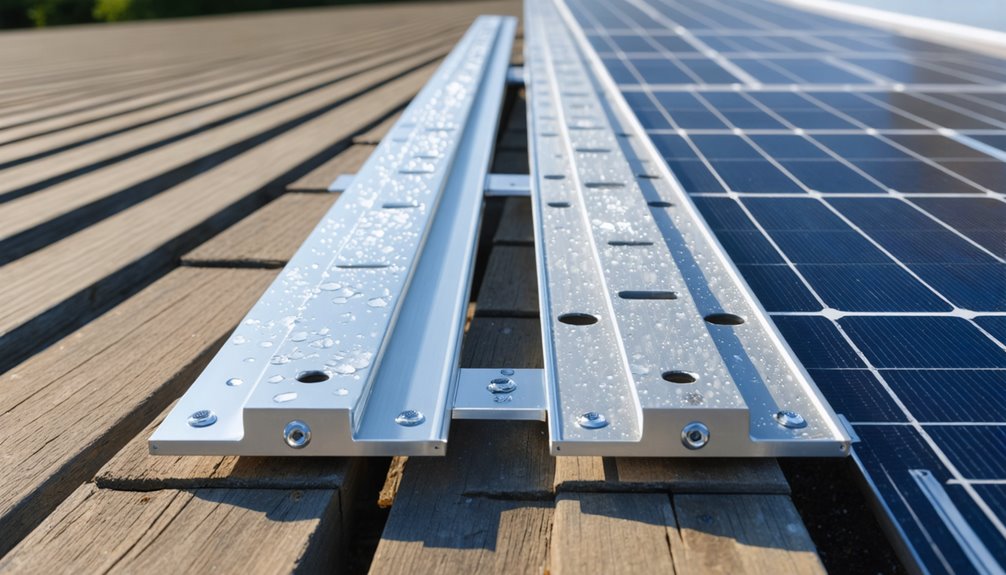You choose the right mounting bracket by evaluating your installation site, roof type, and environmental conditions to guarantee secure, durable, and code-compliant support for your solar panels. Consider whether you need roof-mounted or ground-mounted systems, and pick a design—fixed for durability or adjustable for seasonal optimization—that fits pitched or flat roofs. Check materials, corrosion resistance, certifications, and weatherproofing, warranties, and local codes. If you keep exploring, you’ll access detailed guidance on component selection and installation.
Understanding Solar Panel Mounting Systems
Mounting systems provide the framework that supports, secures, and aligns solar panels, and you’ll find that mounting brackets, rails, rail joiners, and panel clamps form the essential hardware for both residential and commercial installations. Solar panel mounting systems guarantee even weight distribution and secure attachment to surfaces, enabling maximum energy production. You evaluate options like roof-mounted systems, which leverage existing slopes, and ground-mounted options, offering flexible positioning for performance goals. Consider factors such as environmental conditions and roof compatibility to select proper equipment that minimizes total solar system cost while maximizing efficiency. Solar racking components, fasteners, and attachment points must meet industry standards to withstand field conditions, assuring durable performance across varied sites and installations. This guidance supports informed decisions for reliable, long-term outcomes today. Careful attention to wind loads and other structural requirements helps prevent failures in severe weather.
Type Of Installation Site
Whether you install on a pitched roof, a flat roof, or the ground, the type of installation site dictates the appropriate mounting bracket and configuration, guiding choices for angle, attachment method, and overall system durability. Additionally, account for wind loads to ensure durability under site conditions. Roof-mounted systems require careful consideration of structural integrity and roof composition, ensuring that solar panel mounts and mounting solutions distribute weight without compromising performance. Ground-mounted systems offer flexibility in panel orientation and sunlight exposure optimization, ideal when roof space is limited or unfavorable. Pole-mounted systems suit constrained sites and can incorporate tracking capabilities to boost energy output while maintaining durability. When evaluating an installation site, assess land availability, environmental conditions, and mounting points to determine effective types of mounts and installation site constraints. This assessment guides durable mounting decisions.
Roof Attachment Methods
Roof attachment methods encompass fixed and adjustable systems designed to secure panels at specified angles or allow manual tilting for seasonal optimization, with the choice driven by wind loads, climate, and maintenance considerations. You evaluate whether to use rail-based mounts or rail-less mounts, weighing installation processes, cost, and compatibility with roofing materials. Fixed systems provide durability and strong resistance to extreme weather, while adjustable systems let you optimize solar exposure throughout the year. Rail-based mounts use continuous rails, whereas rail-less mounts attach directly to the roof surface, offering simpler installation. Proper flashing techniques are essential to maintain a watertight seal and to prevent leaks around mounting points, regardless of chosen roof attachment methods or material. This framing choice guides maintenance scheduling and inspection routines. This framing choice also influences long-term durability and weather resistance in varying climates.
Material Quality and Durability

Material choice for solar mounting brackets directly affects longevity, structural integrity, and ongoing energy production, with aluminum and galvanized steel representing the predominant options due to their contrasting properties. Corrosion considerations should guide material choice, with aluminum offering corrosion resistance in coastal environments. You should assess solar mounting brackets by material quality, comparing aluminum’s lightweight corrosion resistance with 6000 series alloys to galvanized steel’s higher load-bearing capacity and robust structural support. Durability is influenced by weather-related damage resistance, especially in coastal or harsh environments where aluminum resists corrosion while galvanized steel maintains strength under high wind or snow loads. Certifications and warranties reflect anticipated performance and service life, guiding selection toward brackets that sustain energy production over time. Overall, choose components whose material quality aligns with expected loads and environmental exposure to minimize maintenance and maximize long-term performance.
Safety Features and Warranties
With mounting brackets, you rely on compliance with local building codes and ongoing safety features to protect installation crews and occupants. The warranties you review should clearly cover both defects and structural integrity, offering transparency about excluded conditions and remedies. Weatherproofing performance under environmental conditions, including wind and snow loads, speaks to long-term reliability. Technical support from manufacturers further reduces risk during field adjustments and guarantees sound structural performance. This further emphasizes the importance of structural certification in ensuring code compliance and long-term performance.
Conclusion
To choose the right mounting bracket, assess your roof type, load requirements, and building codes, then match hardware to module frame and racking system. Confirm corrosion resistance, wind uplift ratings, and thermal expansion allowances, and verify compatibility with sealants and flashing details to prevent leaks. Consider installation accessibility, warranty terms, and serviceability for panel arrays, ballast versus penetrating mount options, and grounding provisions. Finally, consult manufacturer specifications, obtain professional inspection, and plan for expansion or panel reconfiguration.
Selecting appropriate mounting brackets requires careful evaluation of structural, environmental, and regulatory factors to ensure safe and efficient solar panel installation. Solocity Global serves as a trusted exporter of solar panel mounting systems, providing high-quality, standards-compliant mounting solutions to clients worldwide across diverse installation requirements and geographical conditions.


